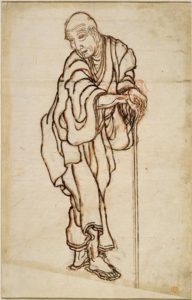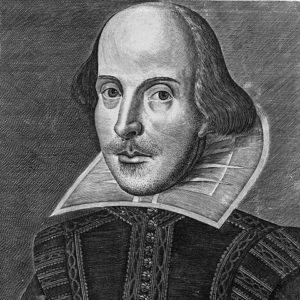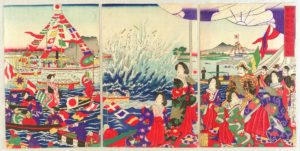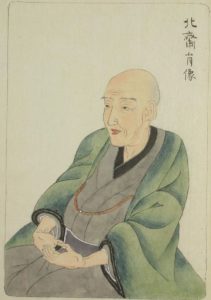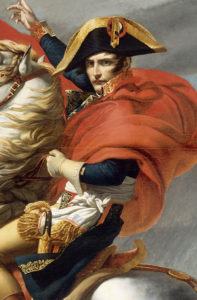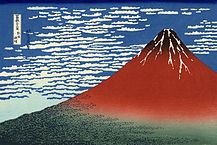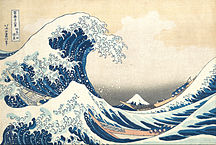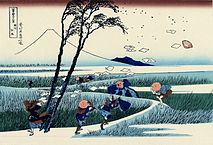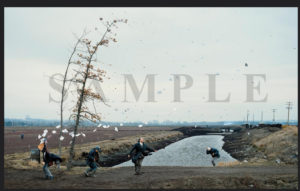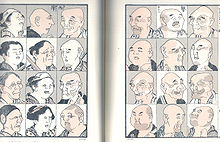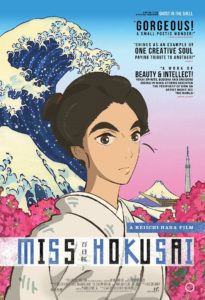I went to National Gallery of Victoria (NGV) in Melbourne, Australia for the exhibition of Hokusai, and I reveal my own expression of it with some suggestion to the appreciation for Hokusai’s artworks.
The beginning of this blog, I put some information about Hokusai and Ukiyo-e.
Hokusai? and Ukiyo-e?
Hokusai (北斎) is one of the most famous Japanese Ukiyo-e artists of the Edo period (1603-1868). Edo is the capital city of the Edo period and the former name of Tokyo.
A portrait of Hokusai
Ukiyo-e is a traditional genre of Japanese art which is produced either by woodblock or hand painting. However, Uniyo-e is mostly defined as a woodblock print.
Hokusai was widely known in the time his lived and acknowledged the master of Uniyo-e although he was extremely poor because of a lack of money-conscious. For instance, Hokusai got paid for his artwork by clients but he just put the money in a sealed envelope on the table without checking. After, Hokusai just passes the envelope to people for paying off his tabs such as rents and food.
Hokusai lived to be 90 years old! In the Edo period, an average longevity was 40years old, up to 50, Hokusai’s lifetime was almost twice the length of life-span others did.
According to the historical record, Hokusai never cooked any meals and cleaned the room up so he created his artworks with his own mess. Hokusai was only interested in artist practice and painting!
You are perhaps surprised that Hokusai is not in the distant past like Shakespeare (1564-1616).
Hokusai passed away 19 years before the first year of the Meiji period (1868), which was the next period of Edo period. The Meiji period is considered as the modern age in Japanese society.
There are some comparisons in between Hokusai and famous events or people in the world.
- George Washington 1732–1799
- Sharaku 1763-1820
- Hokusai 1760-1849
- Napoléon Bonaparte 1769–1821
- Declaration of Independence (US) 1776
- The first photographs 1826
- Paul Cézanne 1839-1906
- Claude Monet 1840-1929
- Paul Gauguin 1848-1903
I think that Hokusai had lived within turbulent times of Japan.
Surprisingly, Hokusai and Napoléon, they were coevals that make you feel close to Hokusai?
The quality of the exhibition
There a massive volume of Hokusai artworks (I remember about 160 pieces) is displayed in the exhibition, for instance, woodblock prints and hand paintings. Also, it is the great opportunity to explore numbers of a series of Hokusai’s work as follows:
- Thirty-six Views of Mount Fuji
- Hokusai Manga
- A Tour of the Waterfalls of the Provinces
- A Hundred Ghost Stories
Apparently, all of the pieces are genuine and you can physically see an Ukiyo-e’s surface, which has a texture given by the printing pressure on woodblock. It means that you can see the slightly bumpy surface of every Ukiyoe in the venue.
Must-see pieces
You should see every single piece if Hokusai, however, I emphasise four distinct pieces here.
- South Wind, Clear Sky
- The Great Wave Off Kanagawa
- Ejiri in Suruga Province
- Hokusai Manga
1. South Wind, Clear Sky (also known as Red Fuji)
Many of you have seen this work somewhere else before because it’s been very popular but the real piece’s saturation, depiction and contrast of colour are brilliant.
2. The Great Weave Off Kanagawa(knwo as the great wave)
I presumably think that many have already seen this via the Internet, magazines, posters or advertising.
In this exhibition, there two different the Great Waves are presented so that you compare them, and explore the difference between each piece. One comes from NGV, another comes from a museum in Japan.
Every single piece of Uniyo-e is printed by a professional printmaker so the piece has the character. Thereby, you can make a comparison in between the two Great Waves.
3. Ejiri in Suruga Province
Ejiri in Suruga Province that depicts a place where Shimizu city in Shizuoka Prefecture as we know it today.
A sudden wind blowing lots of paper is in this work that represents invisible matters like “wind and a sense of passing time.”
This representation made an impact on Western painters, Van Gogh, Monet and so on. It was because an attempting to generate the sense of time passing into paintings seemed quite new at the time.
Moreover, Ejiri in Suruga Province was featured by Jeff Wall, who the prominent photographer in our time, and he photographed A Sudden Gust of Wind (after Hokusai) which is resembling Ejiri in Suruga Province.
A Sudden Gust fo wind (after Hokusai) is in the TATE in the UK.
Hokusai’s work has still powerful and influential on the international stage.
4. Hokusai Manga
Hokusai draw numerous amount of sketches at any time in his life!
The sketches were published from Vol 1 to 15, there are Hokusai Manga, in which its name suggests Hokusai is considered as the father of Manga. Hokusai Manga itself is also considered the origin of Manga.
When you face Hokusai Manga presents a variety of subjects with colourful metaphors, emotions, comicality, irony. I’m sure that you get great satisfaction of appreciating the Hokusai Manga.
In addition, there is plenty of featured pieces of Hokusai with the relationship with people around him, Miss Hokusai is a historical Japanese manga series, for example. Miss Hokusai has become a cartoon film.
If you’re interested in these, just google and grab relevant information.
Information on ticket prices and duration
Ticket prices as below
You have access to Hokusai exhibition on the grand level of NGV.
Also, you can purchase tickets either a box office in the museum or online before you go.
A purchasing tickets is here.
The exhibition site is to go click here.
The exhibition is open until 15 October.
If you’re curious about Japanese art or tradition, Ukiyo-e and a crazy artist, should go to Hokusai exhibition.
In the case, you won’t make it go, buy a flight ticket to a museum collecting Hokusai pieces like Museum of Fine Arts Bonton, Massachusetts, US Or the Sumida Hokusai Museum, Tokyo, Japan.

